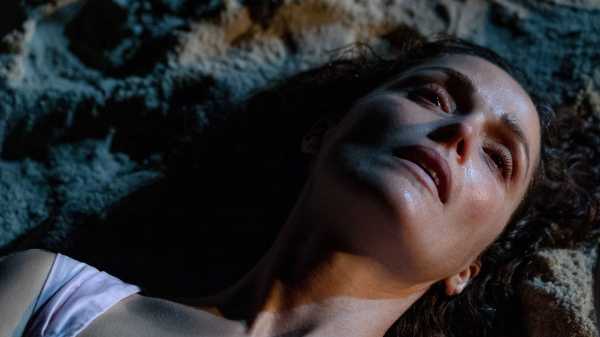
Save this storySave this storySave this storySave this story
I’ve never been to Park City, Utah, where the Sundance Film Festival takes place, but for years I’ve been going to Sundance in New York, thanks to press screenings here of some of the festival’s most notable offerings. And, ever since the pandemic gave rise to digital festivals, a wider range of Sundance films have been viewable online. Of course, there’s very little festivity to an online festival: crash-course cramming of movies at home while also living one’s regular life is a very different experience from the bubble-like focus on the films that in-person attendance offers; and, because not everything that screens in Park City is available online, it’s impossible to step back and discuss at large a festival experienced at small. Nonetheless, it’s already clear that this year’s Sundance Festival has introduced some movies that don’t merely deserve theatrical release but are noteworthy for their distinctive artistry.
Until now, the filmmaker Mary Bronstein has been a cinematic one-hit wonder; her début feature, “Yeast” (2008), was an emotionally unhinged but thoughtfully composed drama of three female frenemies charging at (and sometimes away from) one another in quests for self-definition. Her second feature, “If I Had Legs I’d Kick You,” shares some key traits with its predecessor: it’s a film of near-constant conflict and tension, and its cinematography is as integral to its flayed-nerve sensibility as is the action itself. Rose Byrne stars as Linda, who’s seen in extreme closeup to start the film, in a scene that shudders the screen as it establishes her stresses and frustrations. She’s in a group-therapy session and is described by her young daughter (Delaney Quinn) as “stretchable,” by contrast with her husband, whom the girl deems “hard.”
It’s soon revealed that Linda’s stretchability is a painful necessity that’s imposed—and tested—by some very difficult circumstances. Her main concern is her daughter’s health; the girl uses a feeding tube, which Linda hopes can be removed soon. She is the primary caregiver, because her husband, Charles (Christian Slater), is a sea captain who’s away from home for extended periods, and for most of the movie. He shows the hardness of his character by his long-distance reproaches to Linda when things at home don’t run shipshape. It’s not much of a symbolic stretch to see the domestic equivalent of shipwreck in a catastrophic leak that makes the family’s apartment temporarily uninhabitable. Linda and her daughter (whose name is never revealed) move to a nearby motel while the landlord’s contractors do the repairs. Meanwhile, Linda is working full time as a therapist in private practice, while also shuttling her daughter to the hospital for examinations and treatments and laboriously preparing the special diet that she is fed through her tube.
Linda may stretch, but not infinitely, and as her nerves fray, her every relationship—old and new—becomes increasingly unbearable. Linda finds her own therapist (Conan O’Brien) insufferably hard-hearted; one of her own patients (Danielle Macdonald) gets ignored in a moment of crisis; a man named James (A$AP Rocky), the super at the motel, befriends her but gets little to show for it but insult and injury. Despite Linda’s devoted efforts, her daughter isn’t getting better, and the girl, who’s heard but hardly seen, vents frustrations of her own. Linda sometimes snaps back, sometimes even neglects her, and turns the girl’s doctor (played by Bronstein) into an implacable adversary. She even manages to make an enemy of a hospital parking attendant (Mark Stolzenberg).
The cinematography, by Christopher Messina, feels as abraded as Linda’s psyche. Bronstein’s relentless direction keeps the camera provocatively close to the character throughout, as if merely looking at her is testing her limits. Byrne’s performance has a hair-trigger impulsiveness to match. Looking empathetically at Linda’s mind-frazzling and physically exhausting efforts to cope with the many demands on her, the movie sets up a confrontation between her and medical institutions that, though remaining unanalyzed, spotlights her unyielding advocacy. Yet Bronstein doesn’t let Linda off the hook. There are practical competencies that she appears not to have mastered, lapses of self-control that at times devolve into mere selfishness. Here, as Bronstein also did in “Yeast,” she sees the fascinating terror of uninhibited fury as a catastrophe, in a way that turns the cinema into a kind of rubbernecking. “If I Had Legs . . .” makes emotional and practical space for the more controlled people whom Linda blasts with hostility, and the finely tuned performances of the supporting actors (especially O’Brien and A$AP Rocky) grant them a measure of dramatic justice.

A still from “OBEX,” by Albert Birney.Photograph by Pete Ohs / Courtesy Sundance Institute
Streaming movies at home alone lacks the festival spirit but it’s very much in the shut-in spirit of one of the festival’s best offerings, “OBEX,” by the independent-film veteran Albert Birney. Birney’s most notable films to date have been fantasies: “Sylvio” (in which he also stars, as a gorilla with an office job), “Tux and Fanny” (an animated comedy in the style of an eight-bit video game), and “Strawberry Mansion” (a retro-futuristic sci-fi romance about the occupational hazards of a dream auditor). Though “OBEX,” too, is a fantasy, it’s also a work of meticulous realism—but the realities that it dramatizes are so unusual and so finely observed that they outshine the imaginative speculations to which they give rise. “OBEX” is a slightly historical tale, set in 1987, in Baltimore (where Birney lives). Birney himself stars as Conor, a computer nerd who lives in a plain little two-story row house with his dog, named Sandy, and advertises in a computer magazine as “Computer Conor,” a computer portraitist. Customers mail him a photo and a check, and he sends back renderings of their likenesses done with characters on a dot-matrix printer.
Conor is, if not agoraphobic, definitely agora-averse. When he goes out, it’s mostly to his patio. A neighbor does his food shopping, leaving it on his doorstep for him to bring in after she leaves; who knows if he gets haircuts or goes to the doctor or the dentist. He’s a movie guy—even more, a home-video guy—with a wall of VHS tapes and three television sets arranged vertically amid them. His house is neat, his habits are orderly, and, with his careful concentration on practical details and his loving attention to Sandy, his methodical life appears full and busy. He has just two problems. First, his neighbor announces that she’ll be moving away soon, so he’ll need to make other arrangements for groceries; second, cicadas, which were emerging by the billion that year, screeching outside Conor’s door, and finding ways to sneak through cracks and crevices into his home. (A messy problem with his printer isn’t a feature but a bug.)
The silky, muted black-and-white palette of Pete Ohs’s cinematography conjures an air of oneiric abstraction that meshes with the action. (Ohs, who also co-wrote and co-edited the film with Birney, has directed features of his own, including “Jethica,” from 2022.) Birney plays Conor as a singular sort of Everyman—the moments of aloneness that are common to everyone have become for him a totalizing way of life. Conor’s passionately absorbing, poignantly observed self-refraction from individuality into idiosyncrasy lends his very reality an air of unreality. Then, in the same magazine in which he advertises, Conor sees an ad: send in a home video of yourself and receive a disk with a video game featuring you as a character. Conor, who likes video games (as charmingly gawky as they were at the time), makes a tape, sends it in, plays the game—and finds that it isn’t only his image that gets included in the phantasmagorical action. Sandy goes missing and, in the resulting search, fantasy takes over both Conor’s life and the movie. There’s much to admire in what follows—a flamboyantly symbolic excavation of all that Conor keeps suppressed in the rigidity of his lonesome routine—and yet it’s actually no stranger (and ultimately not more revealing) than the fine-grained whimsy and utterly entrancing banalities of his ordinary domestic life.

A still from “Life After,” by Reid Davenport.Photograph from Reuters / Courtesy Sundance Institute
There are personal documentaries in which filmmakers are themselves the subject of their exploration, and other, more dialectical ones, in which a filmmaker’s journalistic explorations turn out to be inherently personal. Reid Davenport’s film “Life After” is in the second category, and it’s among the most surprising, insightful, moving, and politically far-reaching documentaries I’ve seen in a long while. It begins with his exposition of the story of Elizabeth Bouvia, a woman who, in 1983, sought the right to die by assisted suicide. She wasn’t terminally ill but suffered from disabilities, including cerebral palsy and arthritis, that caused her terrible pain and also prevented her ending her life independently. She lost the case. Davenport finds a TV interview of her on “60 Minutes” from 1998, but he finds no recent trace of her—not of her life and not of her death—and he decides to investigate.
The investigation not only yields information about Bouvia but also considers political and legal decisions extending far beyond her case and reflects on social attitudes and governmental approaches to disability more generally. Davenport himself has cerebral palsy and uses a wheelchair, and his research into Bouvia’s case is profoundly enriched by his empathetic and sympathetic consideration of her experiences. He discovers, through interviews and archival research, that much of the pain that Bouvia endured was caused by surgeries imposed on her by doctors who presumed to know best about what constituted her quality of life. Frequently appearing on camera himself, Davenport draws a link between legislative action to expand rights to assisted suicide and able-bodied legislators’ assumptions about disability, and about quality of life. He finds that a major factor in the quality of life for people with disabilities is the availability of care that allows them autonomy—and that government cost-cutting is a major reason for their dependence and misery.
In general, Davenport sees advocacy for the so-called right to die as inseparable from a widespread public will to avoid spending money and devoting resources to the disabled. “Life After,” made with a personal fervor that never loses sight of reportorial specifics, outlines a horrific vision of merciless mercy killings in which disabled people would gain the right to die because society hardly recognizes their right to live. ♦
Sourse: newyorker.com







